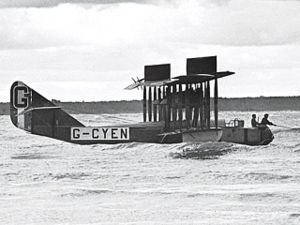Top speed 146 km/h Length 15 m First flight February 1917 | Wingspan 31 m Introduced 1917 Designer John Cyril Porte | |
 | ||
Manufacturers Canadian Vickers, Dick, Kerr & Co., Short Brothers, English Electric | ||
The Felixstowe F.3 was a British First World War flying boat, successor to the Felixstowe F.2 designed by Lieutenant Commander John Cyril Porte RN at the naval air station, Felixstowe.
Contents
Design and development
In February 1917, the first prototype of the Felixstowe F.3 was flown. This was a larger and heavier development of the Felixstowe F.2A, powered by two 320 hp (239 kW) Sunbeam Cossack engines. Large orders followed, with the production aircraft powered by Rolls-Royce Eagles. The F.3s larger size gave it greater range and heavier bomb load than the F2, but poorer speed and agility. Approximately 100 Felixstowe F.3s were produced before the end of the war, including 18 built at Malta Dockyard.
Operational history
The larger F.3, which was less popular with its crews than the more maneuverable F.2A, served in the Mediterranean as well as the North Sea.
In 1920, the Canadian Air Board sponsored a project to conduct the first ever Trans-Canada flight to determine the feasibility of such flights for future air mail and passenger service. The leg from Rivière du Loup to Winnipeg was flown by Lieutenant Colonel Leckie and Major Hobbs in a Felixstowe F.3.
On the 22 March 1921, a Felixtowe F.3 flying boat of the Portuguese Naval Aviation - crewed by the naval aviators Sacadura Cabral and Ortins de Bettencourt, naval navigator Gago Coutinho and aviation mechanic Roger Soubiran - performed the first flight between Mainland Portugal and Madeira.
Operators
Specifications (F.3)
Data from British Naval Aircraft since 1912
General characteristics
Performance
Armament
